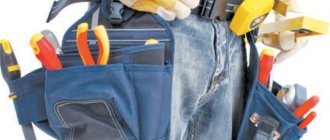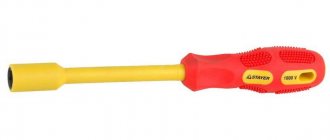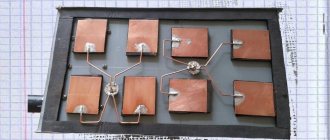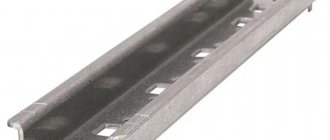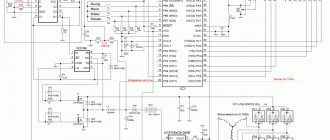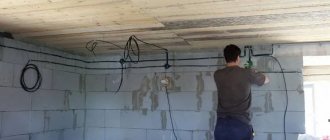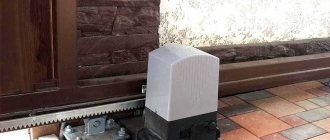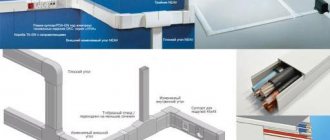List of tools
Basic accessories and tools required by an electrician:
- Drill;
- Drills and nozzles;
- Screwdriver;
- Pliers;
- Wire cutters;
- Nylon ties;
- Calipers;
- Indicator screwdrivers;
- Spanners;
- Screwdriver Set;
- Set of crowns;
- Multimeters;
- Latex gloves.
And this is not the entire list of accessories used by electricians.
Spanners
In some cases, when performing installation work, wrenches may be needed. Although there are many kits available for sale, electricians generally do not need them. You can limit yourself to purchasing an adjustable wrench. It is much lighter and replaces a whole set of keys of various sizes.
In addition to the frequently used tools listed, there are many different indicators and measuring instruments. Let's consider the most necessary of them.
Dielectric gloves
When working with elements that are under electrical voltage, use rubber gloves for insulation.
Before you start using gloves, you need to make sure there are no flaws on them.
When purchasing gloves, you need to check them for quality and durability by filling them with air and clamping the hole intended for putting your hand in. If air escapes, then you need to discard them.
Screwdriver
A screwdriver is a really quick helper. With the help of this tool, even a weak woman can cope with difficult installation or hole-making tasks. Such tools can be used remotely from the mains voltage, since it has two replaceable batteries.
You may be interested in this Resistance measurement
Included or separately is a set of bits that allows you to screw and unscrew screws for metal, wood, concrete and roofing. It is considered one of the professional tools for electrical installation. Convenient and easy to use.
Round nose pliers will help with bending wire strands in sockets
Screwdrivers
Often, an electrician needs different types of screwdrivers for work. They are needed for:
- tightening and loosening contact terminals;
- tightening and unscrewing bolts and screws;
- dismantling broken equipment, etc.
To carry out work, it is better to purchase insulated screwdrivers with long working parts.
Requirements for power tools
The main requirement is the serviceability of all components.
Each tool must be:
- No chips or damage. When using a hammer or sledgehammer, the working part should not hang on the handle.
- Of certain sizes - the jaws of the pliers are not sharpened, the cross-section of the chisel is not knocked down, the walls of the wrenches have smooth edges located parallel to each other.
The tool voltage should not exceed 380/220V under normal conditions. If the room is of increased danger, then this indicator is reduced to 36 V.
Power tools are sent for tests once a month to check the integrity of the insulation. Equipment is allowed to be issued only after diagnostics at the stand and standard meter. In addition, the electrician must independently monitor the serviceability of the tool by visual inspection.
The check is carried out before starting any work, as well as before switching on and after moving to the workplace.
Side cutters
In order to cut wires evenly and easily, you need a device such as wire cutters.
Thanks to the special sharpening of the tool's cutters, they cut through the wire without flattening its edges.
Workplace organization
Before being allowed into the workplace, the electrician is required to undergo instruction - introductory and receive special instructions. This is done by the employee responsible for labor protection.
Before starting work, you need to remove any foreign objects from the area, and also conveniently place the tool around you. Additionally, you need to put up warning signs to prevent strangers from entering the dangerous area.
Tool types
An electrician may have an auxiliary and a main tool. Additionally, equipment is divided into: electrical and installation. The first type is used to check network connections, the second type is needed for laying wires.
List of basic tools for electrical work:
- screwdrivers;
- knives;
- pliers;
- measuring instruments;
- materials for insulation work.
List of tools for cable laying:
- screwdriver;
- perforator;
- wall chaser;
- hammer;
- building level;
- roulette;
- spanners and open-end wrenches.
In addition, there are consumables (heat shrink, electrical tape).
Nylon clamps
To connect several wires into one bundle, ties of various lengths and widths are used. The required clamp size depends on the thickness of the harness.
How to make a transformer with your own hands - step-by-step instructions, diagram, drawings, list of materials + photo of a finished homemade transformerWhich hidden wiring detector is better? TOP 10 best manufacturers with photos and descriptions
Technological maps in construction - what is it?
Using these clamps you can attach wires to anything.
Insulation materials
The presence of insulating materials is mandatory. Electricians use two types of such material - electrical tape and heat shrink.
Both of these types allow you to insulate the connection points to prevent a person from touching exposed live wires.
Insulating tapes can be made of fabric (cotton, lavsan), impregnated with a special insulating glue, or polyethylene, with an adhesive surface.
Heat shrinks are tubes made of insulating material of different diameters, which, when exposed to high temperatures, shrink and adhere to the joint surface.
Strippers
These are devices for stripping wires. However, various tools can be used for this:
- knife;
- pliers;
- wire cutters, etc.
But to use such items you need to have experience.
Pliers, pliers, etc.
Pliers, pliers and wire cutters are also one of the most important tools for an electrician.
Pliers and pliers allow you to twist wires, make the desired bend in the wire, hold it while making connections, etc.
Often, the jaws of the pliers have sharpened blades for cutting the wire, but few people use them, since the quality of cutting the cable with the pliers is low, and the edge of the wire turns out to be somewhat compressed.
It is better to use wire cutters to cut the wire. Their blades have a specific shape, which allows you to make a high-quality cut without compressing the edges of the cable.
A stripper is a special tool that allows you to quickly and efficiently remove insulation from wires, without damaging the wiring cores.
Its use makes it possible to carry out installation work much faster.
Tinning
To ensure protection of the ends of the wires, tinning is carried out using solder. Soldering irons are used for this. They can be of different powers.
- How to fix a laptop that won't charge
Insulated dielectric screwdrivers up to 1000V - tips on how to choose the best manufacturer
Dielectric insulated tool for work - which one is better to choose? Review of manufacturers, photos + video
Soldering iron
Such a device is very necessary for working with electricity, however, it is difficult for them to process very thick wires.
For such purposes, a soldering bath is used; it is extremely rare to purchase, as it belongs to the category of professional equipment.
Therefore, they are used only by large organizations and specialists with extensive experience. In the photo you can see what this tool looks like for an electrician.
Wall chaser
Nowadays it has become very fashionable and aesthetically pleasing to hide and recess electrical wires into the wall. This requires the presence of grooves and furrows, which are made using a wall chaser. This tool is expensive and is most often used exclusively by professionals working in large or private companies.
Externally, this device resembles a circular saw. It is used to obtain grooves in walls or technical channels in the floor for the purpose of subsequent installation of wiring indoors or outdoors. Using the tool, you can control the depth and width of the groove, and at the same time clean from contaminants formed during work. You can also use another available option, for example, a hammer drill. But this is very labor-intensive and labor-intensive.
The included toolkit contains everything in one case
Note! Today, retail and online stores offer a huge selection of electrician kits. From small to large, which are actively used in everyday life.
The list of the most necessary tools for an electrician has been reviewed. The choice and what is more convenient to use will remain with the contractor. The main thing is not to forget the basic rules regarding self-defense and, of course, follow the basic safety precautions when performing.
Indicator screwdrivers
Such screwdrivers are used to determine the phase and check the presence of power supply. Any electrician, even a beginner, cannot do without this device.
Its operation is that when a phase is touched, the lamp in the indicator lights up, but when the neutral wire is touched, it does not.
Measuring instruments
They are absolutely necessary in order to protect yourself and others from electric shock. Before starting work after disconnecting the circuit breaker, it is necessary to check the absence of voltage in the disconnected network using special instruments.
These include:
TIN-1
In order to determine low voltage in the electrical network, this device is used.
It has two probes connected by a wire; one of the probes is equipped with a warning light.
Electrical measuring instruments
An electrician often has to take measurements with electrical measuring instruments. Among the measuring instruments, an important place in an electrician's multifunctional set is occupied by a multimeter - an electrician's device for measuring the resistance of wires, the voltage in them and other network parameters. In some places you cannot expose wires for measurements; they use current clamps. The cable is clamped with lugs, and an inscription appears on the screen. For ease of use, there are combined combined clamp multimeters.
The quality of wire insulation is measured with a megohmmeter. It consists of a dynamo that generates a potential of 500, 1000 or 2500 V. If you measure the current, numbers corresponding to the network resistance will appear on the screen. Current power and other parameters are determined using an optical, radio frequency or low frequency wattmeter. The measuring instruments for an electrician include a voltmeter, which is used to measure the network voltage.
The number of items in a set is often supplemented by a hammer drill. This electrical installation tool is used to make blind and through holes in walls, places for installing sockets, switches, and distribution boxes. The large professional set includes a screwdriver powered by a built-in battery. In the absence of electricity, the master can tighten screws and nuts using additional bits.
Often, when laying wires, a wall chaser is used. Without it, it is difficult to make recesses in the wall in the form of grooves into which electrical cables are inserted.
Multimeter
This measuring device is considered the most reliable for determining voltage.
Currently, there are digital versions of these instruments that measure:
- resistance;
- voltage;
- current strength.
For electricians with little experience, an inexpensive model will be enough, but for professionals it is better to have a model with wide functionality.
Finding hidden wiring
In the practice of every home craftsman, there has certainly been a case when it is necessary to drive a nail into a wall, or make a hole for a dowel, but it is not known where the hidden wiring runs. This happens especially often in apartments and houses of old buildings, the network diagrams of which have been safely lost, or have been changed many times during the renovation process.
To search for such hidden wires, special detectors have been created that work on the principle of detecting electromagnetic fields that inevitably arise around a wire with alternating current. The signal is displayed on a digital scale, illuminates the indicator lamp, or causes the needle to deflect, depending on the design of the device. The most popular models are E121, MS-158 M, MS-18, BOSCH DMF 10. Many models are equipped with light and sound alarms. For home use, it is enough to buy the simplest model, which will indicate the route of the wire with an accuracy of a few centimeters.
Electric drill
It can be said to be a universal tool for an electrician. When working with it, you may need various attachments and drills.
It is advisable that it be equipped with a hammer drill; this is necessary for drilling holes in concrete walls for branch boxes, sockets, and switches.
It would take a long time to list the electrician's accessories, but the main ones are those described above.
Wire cutters
Cutting wires to size and cutting off excess exposed parts of the wire during installation. A necessary tool for both professionals and amateurs. The special configuration of the side cutter jaws allows you to cut through fairly thick copper, aluminum and steel wires without deformation (flattening). This allows you to easily insert the wire into the hole in the terminal block, contact groups of a socket or switch. When purchasing, choose a tool with a small, spring-loaded handle. It is unlikely that you will have to work with large-diameter wires, and for ordinary home wiring, small wire cutters are sufficient. The only requirement is that the handles must be securely insulated along their entire length.
Photo of electrician's tools
Did you like the article? Share 
0

